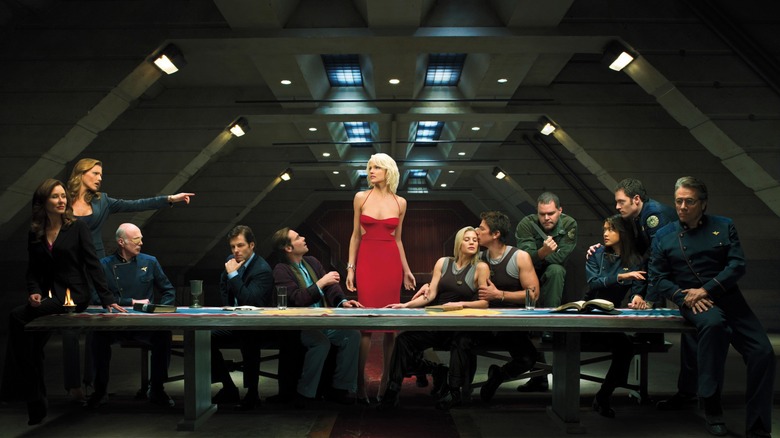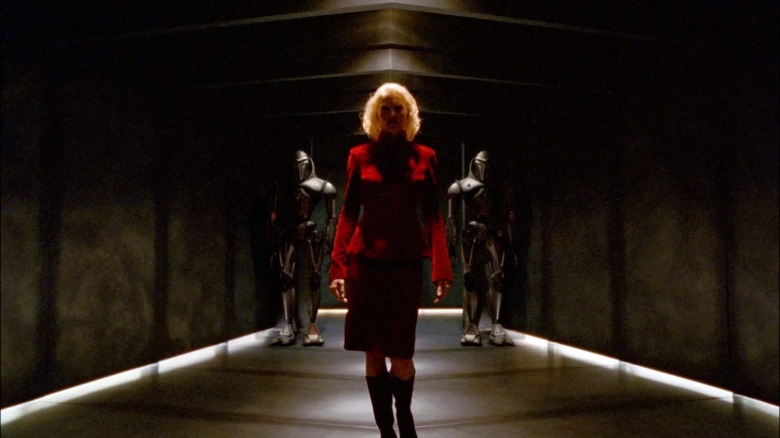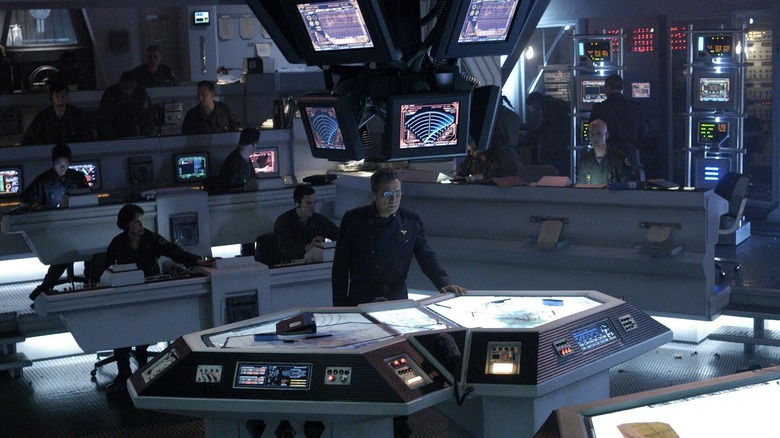Battlestar Galactica's Pilot Sparked A Behind-The-Scenes Battle Before It Even Aired
It's been nearly 20 years since the 2003 reboot of "Battlestar Galactica" propelled the franchise in a wholly different direction. Gone was the light-hearted sci-fi adventure of the original '70s series, replaced with a darker and more relentless tone. But it worked — the new series was popular enough to overtake the original in the public consciousness.
The accolades came after the show started airing, however. The new "Battlestar Galactica" was the brainchild of Ronald D. Moore, fresh off his time as a writer on other shows like "Star Trek: Deep Space Nine" and "Star Trek: Voyager." Despite his time on "Star Trek," Moore still had to fight in order to get his darker, more political vision onscreen.
The pilot episode of the series was where Moore and his production team had the biggest struggle. In fact, the "Battlestar Galactica" reboot almost didn't make it to television. At least not in the form many viewers remember.
Failing a test
According to Moore, the executives were very concerned about how tense and heavy "Battlestar Galactica" was. Those concerns continued as the Sci Fi Channel (which would later rebrand to SyFy) started doing audience tests for the pilot miniseries. In fact, the studio didn't want to start the series with the planned first episode.
"They were, like, so scared of it," Moore told Wired. "That was a whole big fight, and they eventually backed down, but there was a brief period where they talked about not airing them in order. They did one of the infamous controlled tests of the miniseries just before the mini went on the air — like four weeks before we aired or something, one of those marketing testing focus group things. They watched the series. It was one of the worst-rated ever."
The episode in question actually comes after the initial miniseries, and serves as the pilot to the series proper. "33" kicks off the series by depicting the Galactica fleet in its hurried rush to escape the Cylons. The episode title is the gap in time the fleet has to rest before committing another faster-than-light jump. It's the crew of the Galactica at its worst, with constant battles and lack of sleep having worn away any sort of joy or mirth. It's almost understandable that executives might not want to start with that episode.
Too late to change
In the report Moore and his crew received after test screenings, "Battlestar Galactica" was deemed "too dark, too scary." The network expected one thing, a reinvention of a sci-fi adventure show, and received something else entirely. Moore felt that doing justice to the premise — a fleet escaping the destruction of their civilization by the Cylons — necessitated the tone. And by the time the test screenings happened, it was too late to change course.
"Fortunately, it was too late. The show was done, locked, in the can," said Moore. "I think we edited back, we cut out a couple more shots of gore here and there to throw them a bone, but it was way too late in the process to make any serious adjustments. It went to air with this sense of fatalism on the part of the network that, well, were boned here, they're going to hate it, it's too dark. Then they were shocked when the numbers were so good. It really shocked them. It made them reevaluate."
Moore compared "Battlestar Galactica" to another television series that tested poorly prior to release:
"It's like money versus content. They were like, this show shouldn't work. The testing said it won't. But it's all those stories. 'Seinfeld' had one of the worst testings in history, too."
What follows that pilot was one of the cornerstones of that era of television. "Battlestar Galactica" was one of the biggest sci-fi TV shows ever, with great critical acclaim and 19 Emmy nominations over its four seasons. Sure, it stumbled a bit in the end there, but let's consider it part of the television version of the 10-second rule: a little dirt doesn't ruin a great hot dog.


